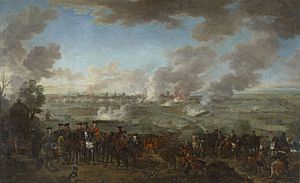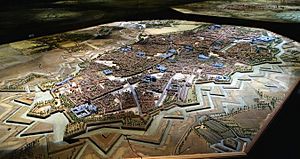Siege of Lille (1708) facts for kids
Quick facts for kids Siege of Lille |
|||||||
|---|---|---|---|---|---|---|---|
| Part of the War of the Spanish Succession | |||||||
 Siege of Lille in 1708 |
|||||||
|
|||||||
| Belligerents | |||||||
| Commanders and leaders | |||||||
| Strength | |||||||
| 35,000 besiegers, 120 heavy guns 80 heavy mortars 75,000 in vicinity |
16,000 garrison, 159 guns 100,000 in vicinity |
||||||
| Casualties and losses | |||||||
| 16,000 killed and wounded | 7,000 killed and wounded 159 guns |
||||||
The Siege of Lille was a major battle during the War of the Spanish Succession. It took place from August 12 to December 10, 1708. In this long fight, the city of Lille, France, was attacked by the armies of the Duke of Marlborough and Prince Eugene of Savoy. The French soldiers, led by Marshal Boufflers, defended the city for 120 days. Even with their strong defense, Lille and its citadel eventually fell to the Allied forces.
Contents
A Daring Gunpowder Delivery
During the siege, a famous event called l'affaire des poudres happened. This means "the gunpowder incident." A French officer, the Chevalier de Luxembourg, led 2,000 horsemen. They bravely rode through the Allied lines. Their mission was to deliver 40,000 pounds of much-needed gunpowder to the defenders inside Lille. They succeeded, which was a big help to the French.
Why Lille Was Important
The attack on Lille was possible because the French army had been defeated earlier. This happened at the Battle of Oudenarde. Also, a lot of supplies arrived in Ostend after the Battle of Wijnendale.
At first, the Allied leaders disagreed on which city to attack next. Some wanted to attack Mons or Charleroi. But the Duke of Marlborough wanted to capture Ypres.
However, Prince Eugene and the Dutch leaders wanted to attack Lille. Eugene believed taking Lille was key to invading France. The Dutch also had good reasons. Lille was a very important and rich French city. It helped pay for a large part of France's war costs. Also, many goods stolen by French privateers from Allied merchant ships ended up in Lille. Capturing Lille would be a huge blow to the French king.
Commanders and the Battle
For most of the siege, Prince Eugene led the forces attacking Lille. The Duke of Marlborough commanded the forces protecting them. These forces kept other French armies from interfering.
In late September, Prince Eugene was injured. So, Marlborough took over command of both groups. He led both the attackers and the covering forces.
On October 22, the Allied armies entered the city of Lille. This was a very costly victory. About 12,000 Allied soldiers were killed or wounded. Marshal Boufflers and his men continued to fight from Lille's strong citadel. They held out for several more weeks. This caused another 4,000 Allied casualties.
The Allies were very skilled at moving their troops. This stopped the French from sending help to Lille. But Boufflers' brave defense made the siege last a long time. It went on into winter, so no more attacks could be made against France that year.
The End of the Siege
The French soldiers in Lille's citadel finally surrendered on December 10. The remaining defenders marched out with full honours of war. This meant they were allowed to leave with their weapons and flags. It was a sign of respect for their brave fight. Marshal Boufflers was even honored by Louis XIV, the King of France.
What Happened Next
For France, the siege had mixed results. The long defense of Lille kept Marlborough busy for the rest of 1708. This stopped him from causing more damage to France after the Battle of Oudenarde.
However, France lost Lille. This meant that northern Flanders came under Allied control again. The Allies then moved on to Ghent and captured that city in late December. The fall of Lille also opened a path for the Allies to invade France in 1709. But this invasion would lead to another very bloody battle, the Battle of Malplaquet.
Gallery



